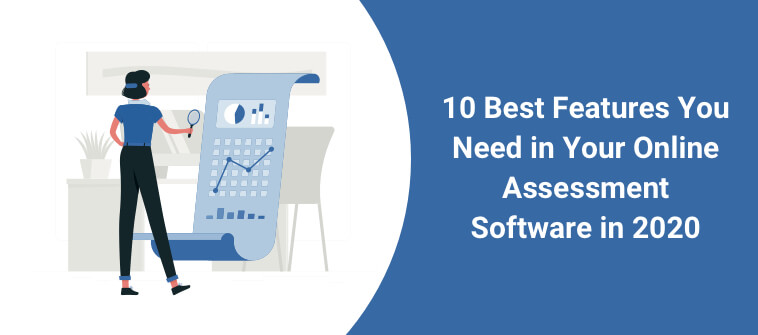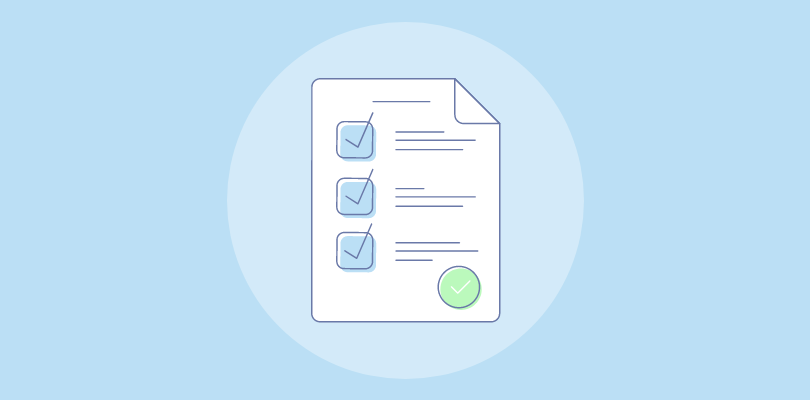Think back to the lessons that truly stuck with you. Chances are, it wasn’t the final grade that made them memorable—it was the feedback, the reflection, the process.
Formative assessment has always been a core part of how we train and develop teams at ProProfs. Not because it sounds good on paper, but because it gives us a real edge—spotting what’s working, what’s not, and where we’re losing people before it costs us time or results.
In this guide, I’ll break down:
- What formative assessment really means (and what it doesn’t),
- Where it shines in both classrooms and corporate learning,
- Practical examples and strategies you can use immediately, and
- How to create formative quizzes that boost engagement, clarity, and outcomes.
Whether you’re an educator, L&D lead, or training manager—this guide will help you use formative assessment to drive better learning, faster.
Let’s begin.
What Is a Formative Assessment? (Definition & Meaning)
Formative assessment is a low-stakes, ongoing process used by educators and trainers to monitor how well learners are grasping concepts while instruction is still in progress. It’s an assessment for learning, not just an assessment of learning.
It’s what helps you say:
“This student didn’t understand topic X—let me tweak my approach before the test.”
“This employee didn’t fully grasp the new compliance policy—let’s revisit it now, not after onboarding ends.”
Formative assessment can take many forms:
- A 2-question in-class poll
- Peer feedback during a group task
- A short self-check after a training video
- Mid-session quizzes with auto-feedback
What matters isn’t the format—it’s the feedback loop. It’s about gathering actionable insights in the moment, adjusting instruction in real time, and helping learners stay on track without the pressure of grades or final evaluations.
In Workplace Learning:
Formative assessments help managers spot gaps mid-training—before they affect productivity or compliance. A quick check-in after a scenario simulation, for instance, can uncover knowledge gaps that would otherwise go unnoticed until it’s too late.
Watch: How to Create an Online Quiz in Under 5 Mins
What Is the Purpose of Formative Assessment?
The core purpose of formative assessment is simple but powerful: to improve learning while it’s still happening.
Instead of measuring what a learner remembers after a unit is complete, formative assessment works in the moment. It helps both the instructor and the learner understand what’s being absorbed, what’s unclear, and what needs immediate reinforcement or a shift in approach.
This makes learning more:
- Flexible: Instructors can adjust pace, content, or method in real time.
- Responsive: Learners get timely feedback that helps them reflect and self-correct.
- Effective: The focus shifts from performance to progress.
Why It Matters:
Waiting until the end of a unit or course to assess learning is like waiting until after a project fails to ask what went wrong. Formative assessment helps you catch those “I didn’t get that” moments before they turn into confusion, disengagement, or low performance.
What It Unlocks:
- Real-Time Adjustments: Teachers and trainers can adapt instruction on the fly—clarifying concepts, offering different examples, or changing delivery methods based on what learners need now.
- Personalized Learning Paths: Because no two learners are alike, formative assessments help surface individual gaps and strengths, allowing for more targeted support.
- Ongoing Engagement: Learners become active participants in the process. They’re not just consuming information—they’re interacting with it, thinking about it, and applying it.
Formative assessment isn’t an interruption to learning. It is learning. It turns every interaction into an opportunity to reflect, refine, and move forward with more clarity.
Formative vs. Summative Assessment: What’s the Difference?
One of the most common misconceptions is that formative assessment is just a smaller version of a test. It’s not. In fact, formative and summative assessments serve entirely different purposes.
Think of it this way:
- Formative assessment is like a GPS—it helps you course-correct while you’re still on the road.
- Summative assessment is the odometer at the end of the trip—it tells you how far you went, but not whether you took the right turns along the way.
Why the Distinction Matters:
Confusing the two can lead to missed opportunities. If you only assess at the end, you’ve already lost the chance to help someone in the moment. If you assess continuously but treat it like a final exam, you risk turning learning into performance.
Both are essential, but they work best when they’re used intentionally.
Quick Comparison Table
| Feature | Formative Assessment | Summative Assessment |
|---|---|---|
| Purpose | Improve learning while it’s in progress | Measure what was learned at the end |
| Timing | Ongoing | End of a unit, course, or program |
| Focus | Identifying gaps, guiding instruction | Evaluating final mastery |
| Feedback | Immediate, growth-focused | Often delayed, outcome-focused |
| Examples (Education) | Exit tickets, class discussions, think-pair-share | Final exams, standardized tests |
| Examples (Workplace) | In-training knowledge checks, live simulations, reflection prompts | Certification exams, post-training evaluations |
| Grading | Usually ungraded or low-stakes | Graded and high-stakes |
| Learner Involvement | High — learners reflect and adapt | Passive — learners complete and move on |
When used together, formative and summative assessments can complement each other. One shapes the learning journey; the other reflects on where that journey ends.
Types & Examples of Formative Assessment
Formative assessments come in many formats, each designed to provide timely feedback and support learning while it’s still in motion. Whether you’re working with students, employees, or trainees, the goal stays the same: to gain insight and adjust instruction in real time.
Below are common types of formative assessments, along with examples from both classroom and workplace settings.
1. Quizzes and Knowledge Checks
Short quizzes are one of the most versatile tools in formative assessment. They’re quick to deploy and easy to analyze.
- In Education: Weekly mini-tests or topic-based MCQs to reinforce core concepts.
- In Training: In-module knowledge checks during onboarding to spot confusion before it impacts performance.
You can use auto-graded quizzes to save time, and offer explanations right after each question to reinforce learning on the spot.
Watch: How to Use Online Quiz Maker for Teachers
2. Observations and Live Monitoring
Watching learners interact with material or each other can reveal more than test scores ever will.
- In Education: Walk around during group activities to catch misconceptions and offer just-in-time feedback.
- In Training: Observe how employees solve a scenario during a live workshop or simulation.
3. Interactive Discussions and Polls
When learners explain ideas aloud or respond to quick polls, you can instantly gauge their grasp of the topic.
- In Education: Think-pair-share, Socratic questioning, or quick in-class polls.
- In Remote/Hybrid Training: Use live chat or polling tools (e.g., Slido, Zoom polls) to surface understanding in real time.
4. Exit Tickets
A one-question wrap-up at the end of a session that asks learners to reflect, summarize, or raise a question.
- “What’s one thing you learned today?”
- “What’s still unclear?”
- “How would you explain this to a friend?”
These help surface patterns and guide your next lesson or meeting.
5. Peer and Self-Assessment
Encouraging learners to assess their own or each other’s work builds metacognitive skills and fosters accountability.
- In Education: Peer reviews for essays or projects, or self-rating checklists during lab work.
- In Corporate Learning: Team feedback loops or reflection journals tied to real tasks.
6. Learning Journals and Reflections
Prompts that ask learners to pause, reflect, and connect what they’ve learned with prior knowledge or real-world applications.
- “What was challenging about today’s topic?”
- “What would you do differently next time?”
- “How does this apply to your role/team?”
These insights can’t be captured by scores—but they’re critical for deeper learning.
7. Hands-On Demonstrations or Simulations
In skills-based contexts, asking learners to demonstrate a process or complete a task can serve as a powerful formative assessment.
- In Education: Science experiments, roleplays, or project prototypes.
- In the Workplace: Sales pitch simulations, support ticket triage drills, or software navigation walkthroughs.
By mixing and matching these types of formative assessments, you can build a learning environment that is responsive, personalized, and grounded in real-time feedback. It’s not about adding more tasks—it’s about embedding insight into what you’re already doing.
FREE. All Features. FOREVER!
Try our Forever FREE account with all premium features!
What Is the Process of a Formative Assessment?
Formative assessment isn’t about collecting data for the sake of it. It’s a way to observe how learning is unfolding—and to influence what happens next. Each step in the process serves a clear purpose: to inform decisions, not just record performance.
1. Define What Success Looks Like
Start by identifying what you want learners to demonstrate. Be precise. Instead of “understand negotiation skills,” aim for “identify and compare two negotiation techniques.”
This anchors the assessment in something observable and useful.
2. Choose the Right Format
Decide how you’ll gather insight. It might be a one-question check-in, a written response, a brief role-play, or a live poll. Pick the method that reveals how well the learner is processing—not just recalling—what’s being taught.
Your format should fit the goal, not just the schedule.
3. Build It Into the Learning Flow
Introduce the assessment while instruction is still in progress—not after everything’s been delivered. This ensures you still have time to respond and improve the outcome.
If your assessment feels like a break from learning, rethink how it’s placed.
4. Review the Responses With Intention
You’re not grading—you’re scanning. Look for misunderstandings, gaps in logic, or signs that learners are on the wrong track. Prioritize patterns over individual errors.
This should take minutes, not hours.
5. Respond With Useful Direction
Feedback should clarify what to adjust, not just point out what’s missing. Give learners something to act on—whether that’s refining an idea, practicing a skill again, or approaching a task differently.
Focus on what’s next, not what went wrong.
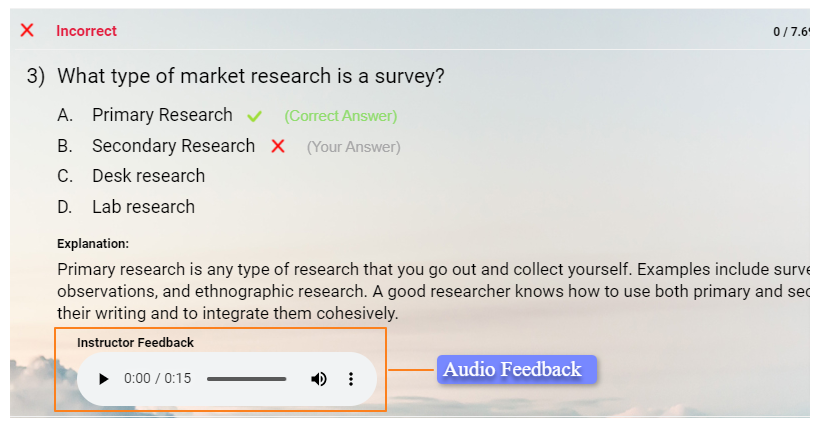
6. Adjust Your Approach
Use what you’ve learned to refine how you teach or train. Maybe it’s a shorter explanation, a new example, or a regrouped activity. Even a small shift can resolve a learning gap if it’s well-targeted.
This is where formative assessment earns its value—in what you change because of it.
7. Evaluate the Assessment Itself
Take a moment to reflect. Did this approach give you what you needed? Did it highlight the right issues? Was it manageable?
Your process will get sharper over time if you regularly ask these questions.
Strategies for Effective Formative Assessments
Formative assessment works best when it’s built into your teaching, not tacked on afterward. To make it truly impactful, it needs to be fast, targeted, and flexible enough to adapt to your setting—whether in-person, online, or hybrid. These strategies will help you gather meaningful insights without burning time.
1. Embed Assessments Into Instruction
The most efficient formative checks don’t interrupt the lesson—they are the lesson. Instead of planning extra activities, convert what’s already happening into insight:
- After a demo, ask learners to explain it in one sentence.
- During group work, drop in with a guiding prompt and note responses.
- End with a one-question exit slip to check retention.
These low-friction moments can tell you far more than a formal quiz.
2. Match Method to the Learning Outcome
Different skills require different checks. Use:
- Multiple-choice or polls for factual recall
- Peer critique or case responses for higher-order thinking
- Audio/video uploads for reasoning or communication skills
Form beats variety—choose methods that give you the clearest view of progress.
3. Generate Assessments Faster With AI
Formative checks shouldn’t slow you down. Tools like ProProfs Quiz Maker let you generate customized quizzes in seconds using AI. Input your topic or learning goal, and the system creates ready-to-use questions in multiple formats—so you spend less time writing and more time teaching.
Watch: How to Create a Quiz Instantly With AI
4. Use Scalable Tech for Feedback at Speed
For large classrooms or corporate teams, automation matters. Pick platforms that:
- Auto-grade diverse question types
- Deliver instant feedback to learners
- Offer built-in analytics to identify trends and flag weak spots
This turns formative assessment from a manual chore into a strategic asset.
5. Teach Self-Assessment With Structure
Reflection only works when students know how to do it. Don’t just ask them to “self-evaluate”—equip them with:
- Clear rubrics or checklists
- Sample responses that model expectations
- Guided prompts like “What did I struggle with today, and why?”
This builds autonomy and drives real metacognition.
6. Make It Work in Remote and Hybrid Settings
Formative assessment isn’t location-dependent. Try:
- Google Forms, Padlet, or polling tools for quick responses
- Shared docs for asynchronous collaboration
- Video check-ins for personal reflection in online environments
Focus on online test maker tools that reduce friction—not add new platforms to learn.
7. Reinforce Accountability Without Grading Everything
Support doesn’t mean letting go of structure. Keep learners engaged and responsible by:
- Grading for completion instead of accuracy
- Using peer scoring with light guidance
- Tracking participation across multiple touchpoints
You’re not assigning a letter grade—you’re signaling that effort and feedback matter.
10 Advantages of Formative Assessment
When done right, formative assessment isn’t just a teaching tactic—it’s a high-leverage move that transforms how people learn, perform, and grow.
1. Drives Deeper Understanding
Formative assessment turns passive learning into active engagement. Students don’t just absorb—they interact, reflect, and apply. That repetition in action solidifies understanding and builds real retention.
Luc Viatour, a math educator teaching over 1,500 learners globally, used ProProfs to deliver timely feedback through formative quizzes. His results? Higher engagement, less reliance on final tests, and clearer visibility into who’s progressing—and who needs help.
“ProProfs was a revelation. We searched for a long time before finding it—it was a miracle for us.” – Luc Viatour
Watch: How Luc Viatour Transformed Education for 1500+ Daily Learners
2. Enables Instant Course Correction
When feedback happens in real time, students and instructors don’t have to wait for grades to find out what’s not working. That allows for immediate tweaks—before confusion turns into lost progress.
3. Personalizes the Learning Journey
Not every learner is on the same track. Formative assessments help identify who’s ahead, who’s behind, and why. That insight allows you to tailor your support—delivering the right challenge or reinforcement at the right moment.
4. Increases Ownership and Motivation
People perform better when they’re part of the process. By giving learners a voice—through peer review, self-assessment, or quick feedback tools—you create a learning environment where they feel invested, not just tested.
5. Builds Critical Skills, Not Just Knowledge
Formative assessments promote higher-order thinking. Reflection journals, peer evaluation, and open-ended prompts nurture self-awareness, analytical thinking, and the ability to receive and apply feedback—skills that go far beyond the curriculum.
6. Fosters a Growth Mindset
When learners know they can try, reflect, and improve without penalty, they stop fearing mistakes—and start learning from them. That mindset shift lays the foundation for long-term growth and resilience.
7. Strengthens Teacher-Learner Connection
Ongoing check-ins and feedback build rapport. Learners feel seen. Instructors stay connected to progress. The result? A more trusting, effective relationship that fuels performance on both sides.
8. Empowers Data-Driven Instruction
Formative data isn’t just nice to have—it’s the engine of better teaching. With platforms like ProProfs, you get dashboards that surface patterns, skill gaps, and learning curves—making it easier to adapt instruction fast.
9. Reduces Performance Anxiety
Frequent, low-stakes feedback removes the pressure to “get it right” on one big test. Over time, learners grow more confident and less anxious—because they’re used to showing what they know in smaller, safer steps.
10. Prepares Learners for the Real Test
Formative assessments are the dress rehearsals. They ensure learners arrive at summative assessments with clarity, confidence, and competence.
Watch: How DMS Boosted Student Scores
Common Challenges Educators Face (and How to Solve Them)
Formative assessment is powerful—but not frictionless. Real-world classrooms and training environments bring constraints that theory often ignores. Below are the most common obstacles, along with practical ways to overcome them.
1. Time Constraints in Busy Classrooms
Teachers often hesitate to use formative assessment frequently because they feel stretched thin. Quick grading, large classes, and packed schedules make traditional feedback seem unmanageable.
Solution: Use low-effort, high-impact methods like:
- Exit tickets that take 1 minute to analyze
- Peer/self-assessment to share the workload
- Auto-scored online quizzes with instant feedback
Platforms like ProProfs let you set up reusable assessments, automate grading, and generate detailed reports—freeing up time while increasing visibility.
2. Lack of Student Buy-In (Especially for Ungraded Tasks)
Students may dismiss formative activities as “not serious” if they aren’t graded, especially in high-pressure academic or certification settings.
Solution:
- Use completion-based grading or light participation points
- Set clear expectations: explain how feedback now prevents poor performance later
- Use real-world framing—“This helps you avoid surprises on the final”
For corporate teams, frame it as performance feedback that leads to faster growth, not judgment.
3. Honest Feedback is Hard to Get
In group discussions or peer reviews, learners often give “safe” answers or copy each other to avoid standing out or being wrong.
Solution:
- Make feedback anonymous using tools like polls, digital whiteboards, or online quizzes
- Normalize error-making as part of learning
- Mix it up: vary your assessment methods so it doesn’t feel like a ritual
Psychological safety boosts honest participation—and that leads to better learning signals.
4. Formative Assessment Feels Like Extra Work
Especially in hybrid or under-resourced environments, instructors worry that every new activity adds prep time or complicates lesson flow.
Solution:
- Embed assessments inside the lesson—not after it
- Repurpose existing materials into short checkpoints
- Use AI-powered tools like ProProfs to auto-generate formative quizzes from lessons or videos
Make formative assessment the “default mode” of teaching, not a separate step.
5. Mismatch With Admin Expectations
In some schools and organizations, leadership demands rigid data reporting—even for informal assessments. This turns a flexible process into a paperwork burden.
Solution:
- Track performance using online quiz makers for teachers with built-in analytics dashboards
- Align assessments with required learning objectives so reporting becomes seamless
- Share aggregated trends (not individual student data) to meet accountability goals without micromanagement
FREE. All Features. FOREVER!
Try our Forever FREE account with all premium features!
How to Create a Formative Assessment Quiz
If you’re using an intuitive quiz tool, such as ProProfs Quiz Maker, the process for creating a quiz is quite straightforward. Here’s how to create a formative assessment quiz in five quick and easy steps:
Step 1: Click “Create a Quiz” on your dashboard.
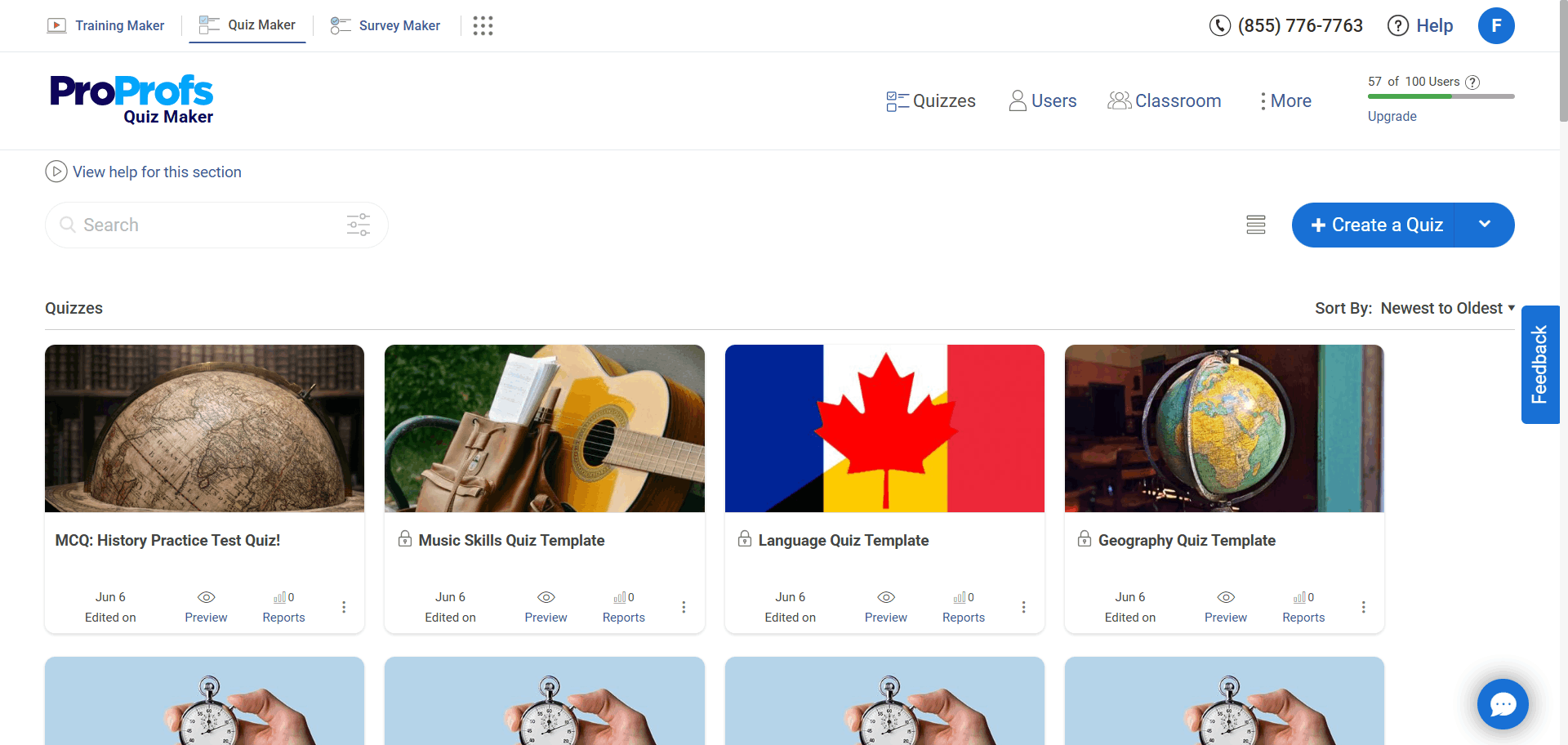
Step 2: Pick a ready-to-use quiz, create a quiz with AI, or build it from scratch.

Step 3: Add/edit the quiz title, description & cover image.
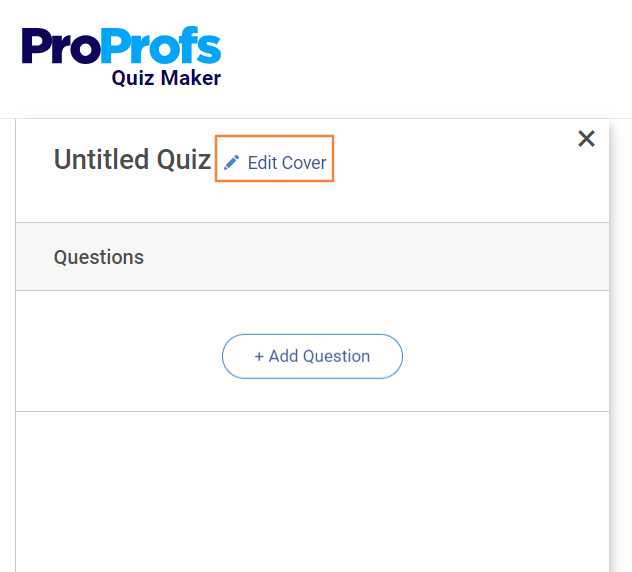
Step 4: Add/edit questions.
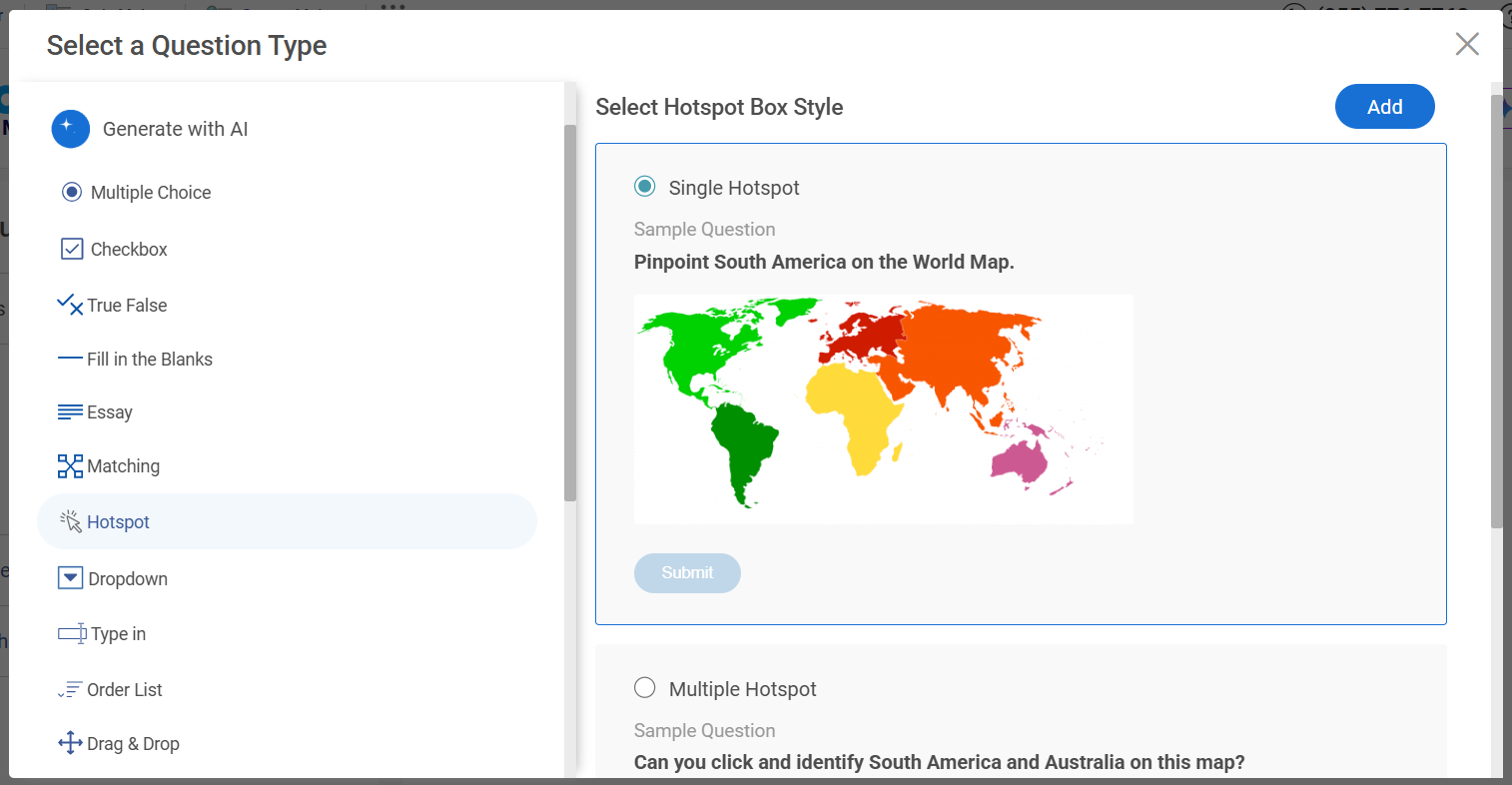
Employ a variety of question formats to explore diverse knowledge and skill areas, guaranteeing a thorough examination of the topic at hand.
- Multiple-choice (for fast checks)
- Drag-and-drop or hotspot (for visual/spatial tasks)
- Open-ended reflection questions (to spark metacognition)
- Scenario-based or role-play questions (for application)
This variety keeps learners engaged and gives you richer insight into their thinking.
Watch: 20+ Question Types for Online Learning & Assessment
You can add new questions by:
- importing them from 1,000,000+ ready-to-use questions
- using ProProfs AI to generate questions instantly
- creating them by yourself
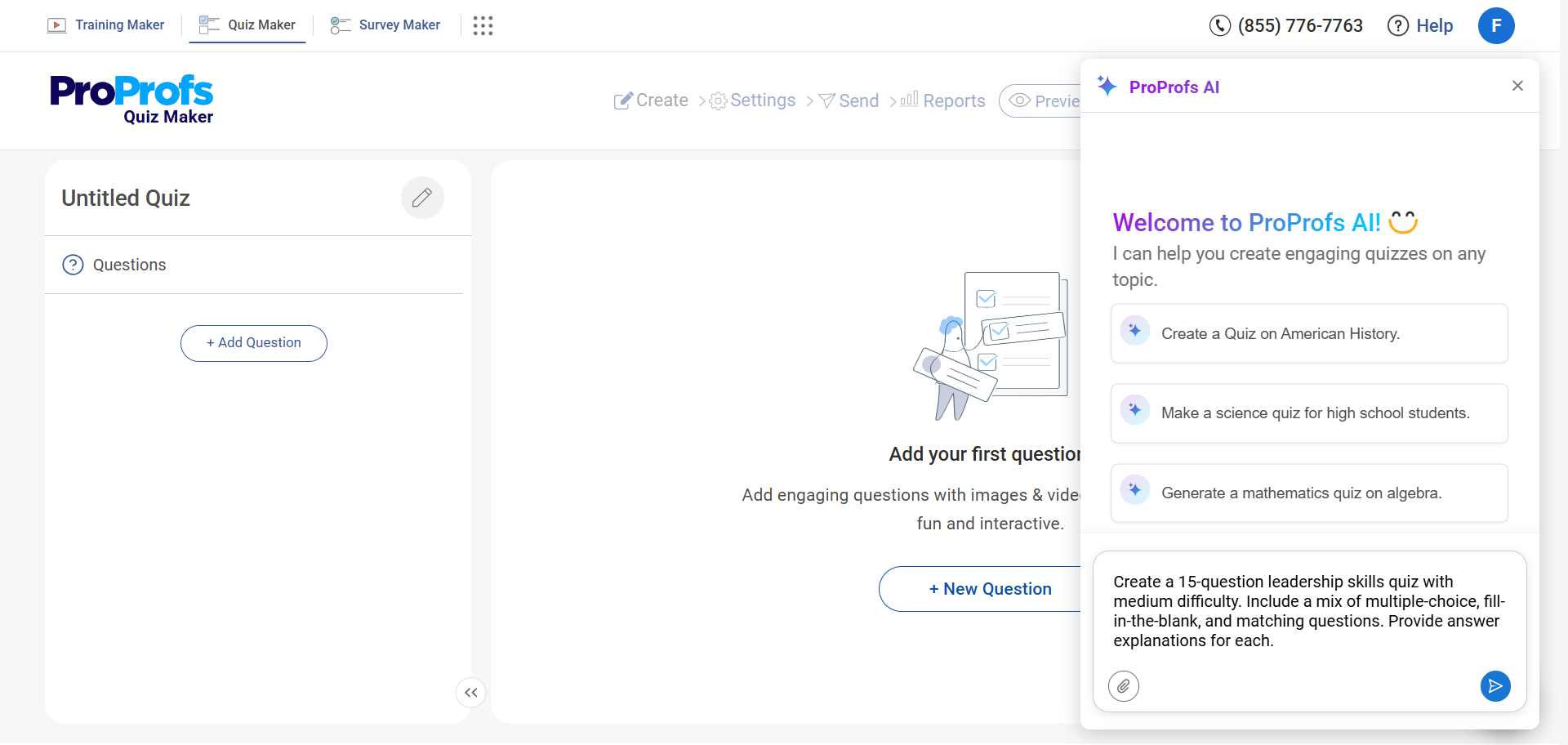
You can add images, videos, audio clips, and docs to your quiz.
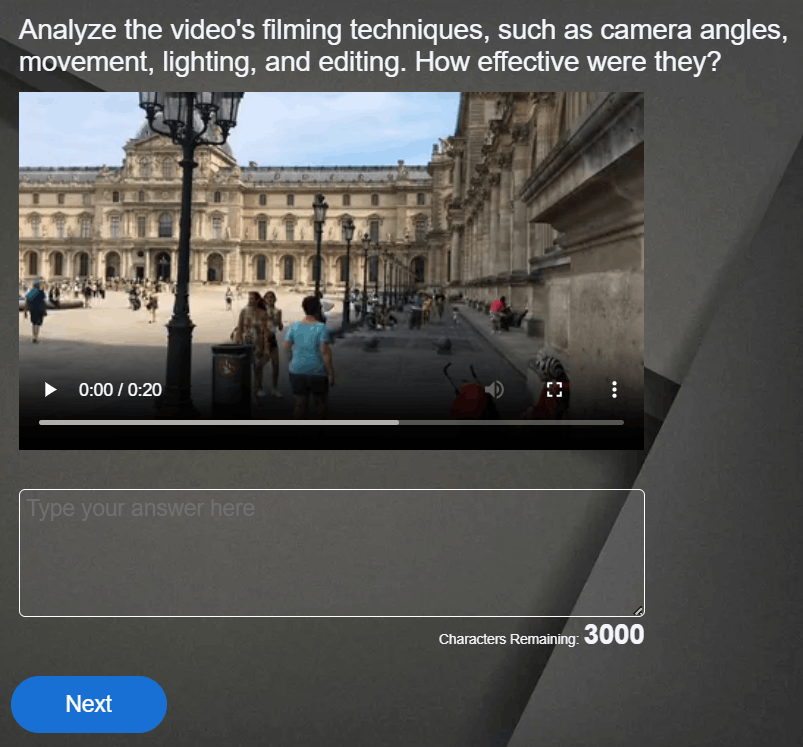
You can also automate the grading of your quizzes to save time and effort, which you can invest in providing individualized support to your learners.
Watch: How to Automate Quiz Scoring & Grading
You also have the option to offer explanations for answers immediately after a question is answered in the quiz. This instant feedback not only supports the learning process but also enables students to recognize areas requiring improvement.
Step 5: Configure settings.
You can implement several security and anti-cheating measures, including:
- Setting your quiz to be private and secured with a password
- Randomizing the sequence of questions and/or answer choices
- Developing a question pool and drawing a random selection of questions for each participant
- Overseeing the quiz through screen sharing, webcam, and microphone monitoring
- Preventing tab switching, printing, copying, downloading, and repeated attempts
You can also change the quiz’s appearance by adjusting the background, colors, fonts, and button text. Plus, you can set the quiz to appear in the participant’s native language.
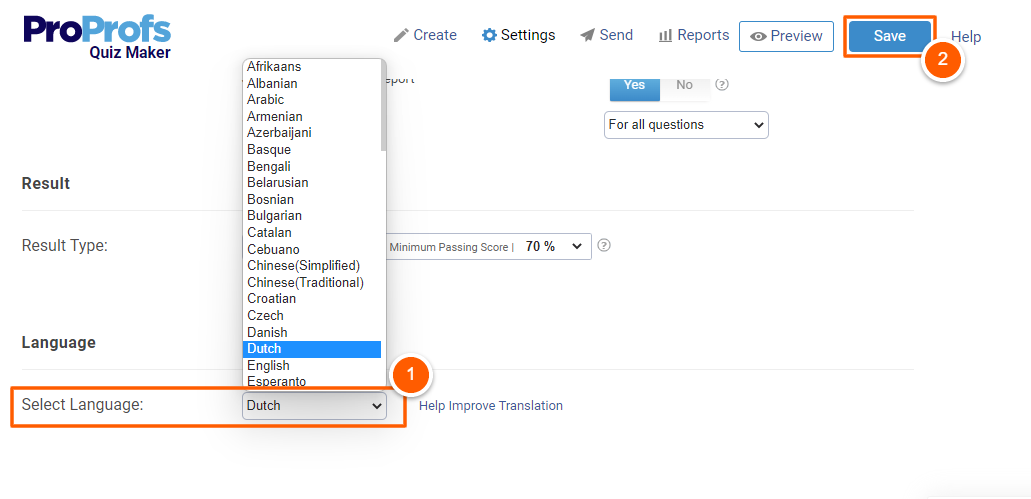
That’s it. Your formative assessment quiz is ready.
Step 6: Analyze the Results
Once the quiz is live, your job shifts to analysis. With detailed reports provided by tools like ProProfs, you can:
- Track performance by question, topic, or learner
- Identify patterns across teams, classrooms, or training cohorts
- Export clean, visual reports for leadership or compliance
This transforms a simple quiz into a strategic decision-making tool.
Watch: How to Review Quiz Reports & Statistics
Key Takeaways
- Formative assessment isn’t optional anymore—it’s a strategic lever for improving learning outcomes across classrooms and teams.
- It works because it’s low-stakes, high-feedback, and designed to surface what’s working (and what’s not) before it’s too late.
- The best formative assessments are embedded into instruction, not bolted on. Think short, timely, and reflective—not long and summative.
- Using tools like ProProfs Quiz Maker, you can build, automate, and scale formative assessments—powered by AI and backed by detailed analytics.
- Whether you’re in education or corporate training, formative assessment is your best bet for adapting in real time, personalizing learning, and boosting retention.
Transform Learning With Smarter Assessment
Formative assessment isn’t a side activity—it’s how impactful teaching and training actually happen. It gives you the real-time insight to spot confusion early, personalize instruction, and keep learners progressing.
With the right approach, you don’t need to wait for final exams or end-of-course reviews to know what’s working. You can course-correct immediately, build confidence as you go, and create a learning environment that adapts in real time.
And tools like ProProfs Quiz Maker make it all easy. You can create engaging, low-stakes assessments in minutes—powered by AI, rich in feedback, and backed by detailed reports. Whether you’re teaching in a classroom or training a global team, you’ll have everything you need to drive deeper learning, without adding complexity.
Try it out—start with a free plan for quick quizzes or explore more with a trial or a live demo.
Frequently Asked Questions
What is summative vs. formative assessment?
Formative assessments happen during learning to guide real-time improvement, while summative assessments occur after instruction to evaluate mastery. Formative is low-stakes and continuous; summative is high-stakes and final. A classroom poll mid-lesson is formative, while a final exam is a classic summative assessment.
What are the top 5 formative assessment strategies?
Five powerful formative assessment strategies include clarifying learning goals, gathering evidence of progress, giving timely feedback, encouraging peer and self-assessment, and adjusting instruction based on results. Together, they create a dynamic feedback loop that helps personalize learning, boost engagement, and improve long-term understanding.
How to do formative assessment in the classroom
Start by identifying clear learning objectives, then embed short, low-pressure activities like reflections or polls into daily lessons. Provide specific, timely feedback, and use the insights to adapt your teaching. The goal is to make learning flexible, responsive, and more effective for every student.
Can formative assessments be graded?
Formative assessments are usually ungraded, but they can be assigned completion or participation points to boost engagement. The focus should remain on feedback and growth, not scores. When graded thoughtfully, formative assessments can encourage effort without turning them into high-pressure evaluations.
How can I run formative assessments effectively in remote or hybrid learning setups?
Use online tools like quiz makers, live polls, discussion boards, and video reflections to run formative assessments remotely. Provide instant feedback and track performance with detailed reports. Keep assessments short, varied, and embedded in your content to maintain engagement across virtual environments.

 We'd love your feedback!
We'd love your feedback! Thanks for your feedback!
Thanks for your feedback!




